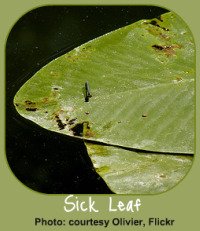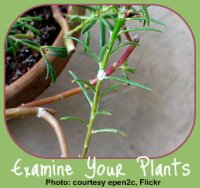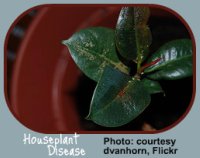Garden Pests
that Plague the Indoor Gardener
The Indoor Gardener has a particular group of garden pests to watch for. Luckily, the list is fairly short and if you're quick, you can save your houseplants and get rid of the problems.
Insects multiply quickly indoors without their natural predators - such as birds - present.
Some spread quickly from plant to plant (others are plant-specific), so be prepared to take care of any problems as soon as you see them.
Check below for help with (a) ways to prevent an infestation of garden pests; (b) first steps to take when all you want to do is panic; (c) identifying the type of garden pests you have on your plants; and (d) a plant first-aid kit to have on hand.
Once you know what type of insect is harming your indoor garden (or for help identifying them), check our separate pages (listed below) for detailed treatment.
An Ounce of Prevention
is Worth a Pound of Cure
The following 12 ounces of regular houseplant care will make it unlikely you'll find many indoor garden pests.
- Use new, bagged soil for potting indoor plants.
- Never use garden soil for houseplants. It's more likely to contain underground insects and garden pest eggs.
- Isolate new plants for about three weeks, checking for garden pests regularly.
- Remove dead or dying leaves or branches quickly.

- Don't let your plants get waterlogged. Over-watering encourages problems, such as fungus gnats.
- Wash planters (sterilize if possible) before re-potting into them, even if they're new.
- If your houseplants vacation outdoors for the summer, isolate them when they come inside. Also, watch them carefully and give the leaves and stems a good bath.
- Check regularly for any problems. Every now and then examine your houseplants with a magnifying glass to search for mites.
- Regular baths with a mild soap and water are good for most houseplants and help discourage surface-dwelling indoor garden pests.
- Make sure your plants get the right amount of water, fertilizer, air, and sunlight. A healthy plant is less likely to develop and succumb to problems.
- Pay attention to where you buy your plants. If you bring an infested houseplant in from a shop more than once, you probably want to buy elsewhere in the future.
- Check many of the plants in the store or nursery where you shop. Even if the one you want appears healthy, if nearby plants have insects, yours might be harboring the next generation.
Most important - pay attention to your plants. Look for leaf spots, leaves dropping, or leaves changing color or curling. These are all signs of your plant being stressed - sometimes by insects you can't yet see.
Don't Panic!

No matter how many preventive steps you take, it's close to impossible for an Indoor Gardener to avoid all invading insects all the time. When you do find bugs on your house plants, take the following steps as soon as possible:
- Isolate the plants with garden pests.
- Identify the problem insect.
- Take pest-specific action.
Identifying the Little Buggers
---er, Bugs
While the list of indoor garden pests isn't as long as that for outdoors, it's important to distinguish what kind of insect problem you have. The cure for each differs. Here's a brief overview. You can find more information by clicking on the links to the pages about each bug. You'll also find out how to get rid of them.
- Aphids - Small spots anywhere. Green, red, black. Tips of new shoots or buds, also under leaves.

- Fungus Gnats - Small, dark. Similar to small flies. Soil surface.
- Mealy Bugs - Oval, fuzzy or cottony. On leaves.
- Scale Insects - Oval bumps. Attached to stems.
- Spider Mites - Tiny dots. Watch for webbing. Under leaves and at joints.
- Springtails - Small, gray. Similar to fleas. jump on top of soil.
- Thrips - Skinny, light brown. Fly-like. Top of leaves.
- Whiteflies - Fly when you shake the plant. Under the leaves.
Other: ants usually indicate an underlying bug problem; other kinds of flies can also be present.
Indoor Gardener Tool Kit
What to Have on Hand
Remember that these are indoor plants, so you may prefer to start your plan of attack with organic insecticides to keep everyone in your home - as well as your houseplants - safe. Read more about Organic Garden Pest Control by clicking here.
Basically, the Indoor Gardener should keep the following on hand so that you can respond quickly to any insects and keep your house plants remain happy and healthy:
- Cotton swabs
- insecticidal or dish soap
- pesticide as a soil additive
- magnifying glass
- rubbing alcohol
Read more about Insect Pest Control by clicking here.
A special thanks to photographer Mick E. Talbot, who generously provided many of the insect photos on the following pages. Click on any of Mick's photos to see more of his collection at Flickr.
Back to Top of Page
Return to Indoor Gardener Home Page










